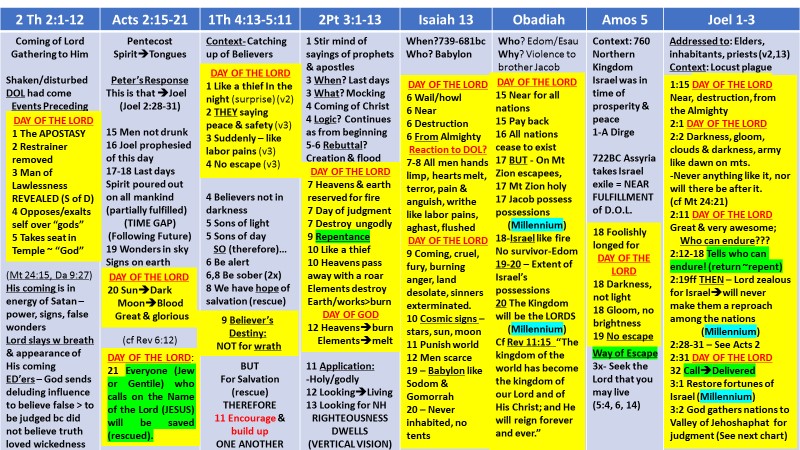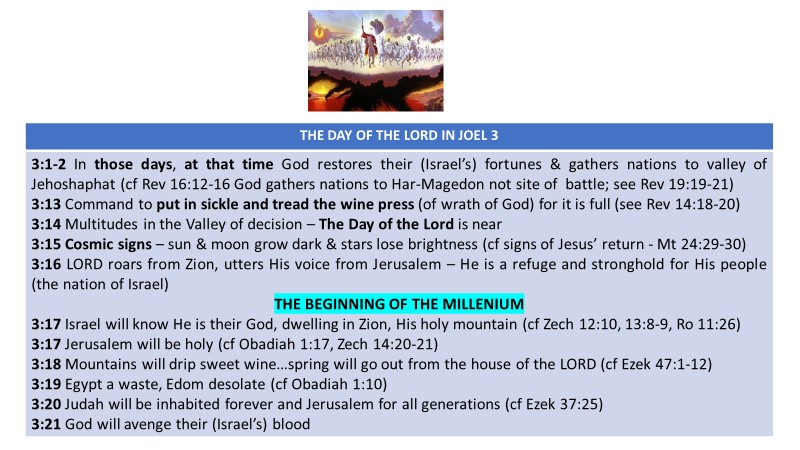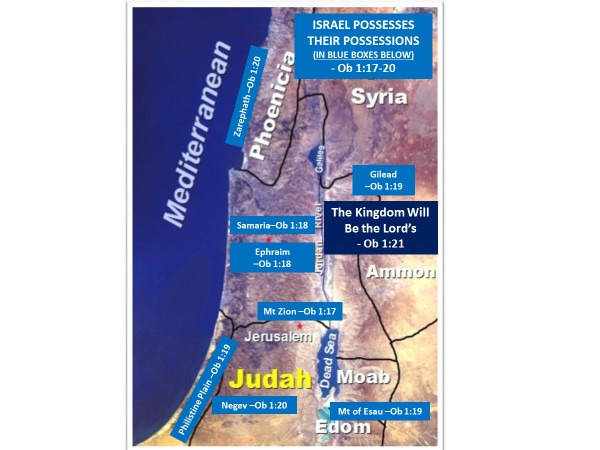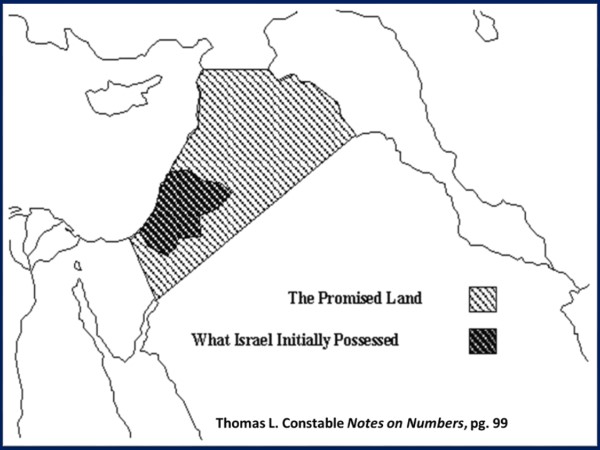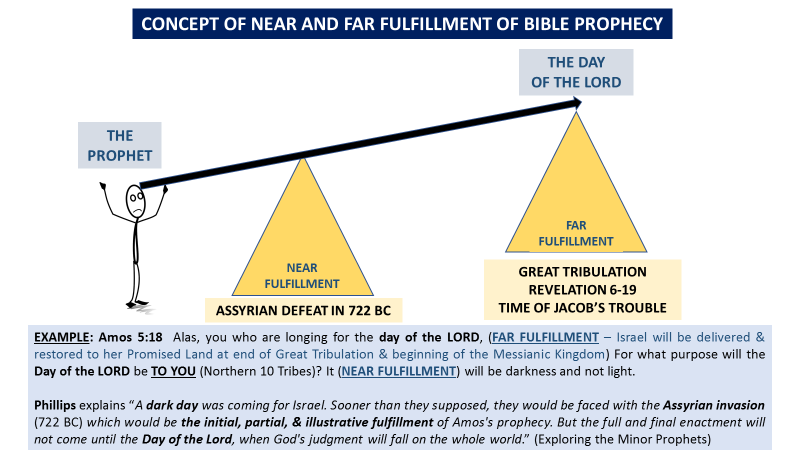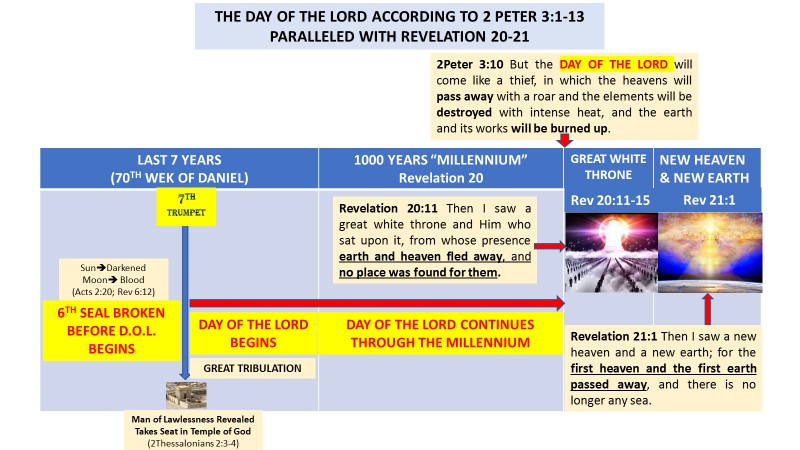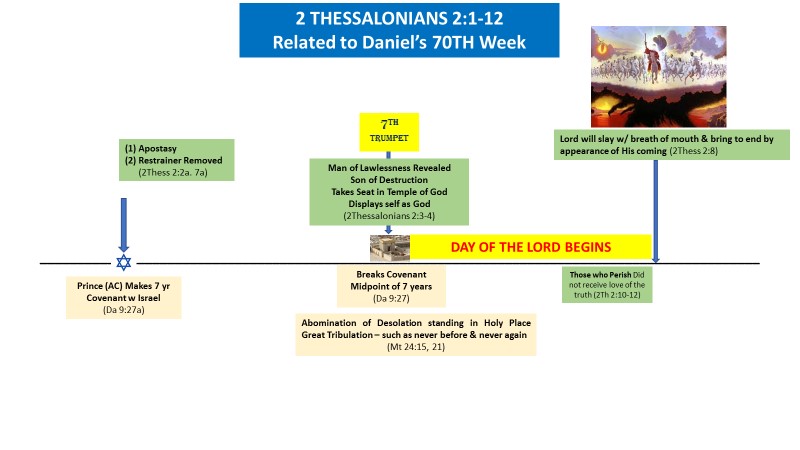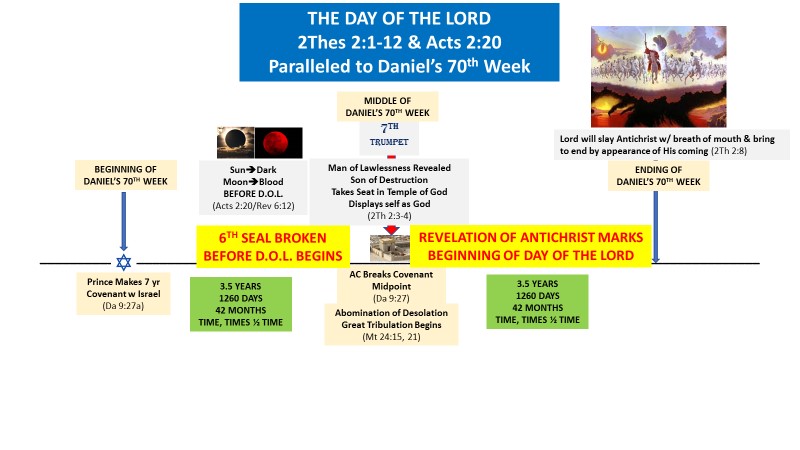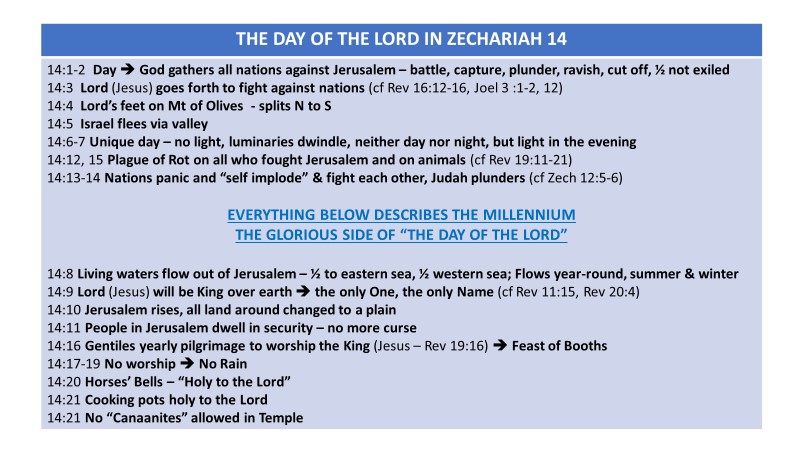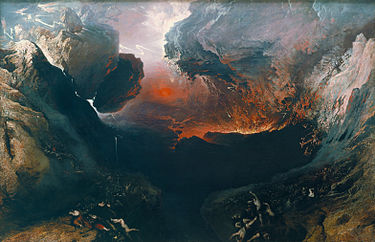
DAY OF THE LORD
"Darkness and Gloom"
(Joel 2:2+)
First, there is a video which represents a question/answer session that reviews 8 books of the Bible to glean what each book reveals about the Day of the Lord (timing, attributes, escape from, etc) - 2Th 2:1-12, Acts 2:15-21, 1Th 4:13-5:11, 2Pe 3:1-13, Isaiah 13, Obadiah, Amos 5, Joel 1-3. The truths about the Day of the Lord are recorded in the chart following the video.

WHAT THE BIBLE TEACHES ABOUT THE DAY OF THE LORD - Part 1
WHAT THE BIBLE TEACHES ABOUT THE DAY OF THE LORD - Part 2|
The charts and diagrams on this page are the result of teaching the Precept class on Revelation Part 4 (Lesson 7 & Lesson 8 - "The Day of the Lord") and thus correspond to the lessons in that study. Each image can be clicked to enlarge.
See also discussion of The Last Days
The prophet Obadiah discusses the Day of the LORD (Obadiah 1:15+) and in that context goes on to describe the fact that in the glorious (Millennial) aspect of the Day of the LORD, Israel will "possess their possessions," (Oba 1:17+) the Promised Land given by Yahweh to Abraham, Isaac and Jacob. The map below highlights (see boxes in blue) Obadiah's prophecy of the lands Israel will possess in the Day of the LORD (Obadiah 1:17-21+). Basically, the directions for the possession expand north, south, east and west. The upshot is that in the Millennium Israel will finally and fully possess all the land originally promised to the patriarchs, something that has never been fulfilled! For comparison see the map of the land originally promised to Israel. It is worth noting that Obadiah does not promise the church she will possess the land, but only the nation of Israel will possess the promised land!
Comment - It should be noted that some writers feel the Day of the Lord described by Peter is a second stage of the Day and that the Day of the Lord does not include the Millennial reign of Christ. In other words they see the Day of the Lord as ONLY a time of doom and gloom. Even one writer, Richard Mayhue, who interprets the day of the Lord as 2 stages (Tribulation time and End of Millennium), writes the following description regarding the Day of the Lord "Most passages speak of God's judgments, but some are tied closely to God's blessing (Zech 14:1-21)." Zechariah 14 forces him to admit that there is a positive aspect to the Day of the Lord. And what does Zechariah 14 describe? Zechariah 14:20 says "In that DAY there will be inscribed on the bells of the horses, "HOLY TO THE LORD."" It describes the blessed time of the Millennium, which would support the premise that the Day of the Lord is a prolonged period which includes the Millennium and ends with the final Day of the Lord in 2 Peter 3:10.
Here is an excerpt from the note by Gotquestions on What is the Day of the Lord? - One key to understanding these phrases is to note that they always identify a span of time during which God personally intervenes in history, directly or indirectly, to accomplish some specific aspect of His plan. Most people associate the day of the Lord with a period of time or a special day that will occur when God’s will and purpose for His world and for mankind will be fulfilled. Some scholars believe that the day of the Lord will be a longer period of time than a single day—a period of time when Christ will reign throughout the world before He cleanses heaven and earth in preparation for the eternal state of all mankind. Other scholars believe the day of the Lord will be an instantaneous event when Christ returns to earth to redeem His faithful believers and send unbelievers to eternal damnation....Besides being a time of judgment, it will also be a time of salvation as God will deliver the remnant of Israel, fulfilling His promise that “all of Israel will be saved” (Romans 11:26), forgiving their sins and restoring His chosen people to the land He promised to Abraham (Isaiah 10:27; Jeremiah 30:19-31, 40; Micah 4; Zechariah 13). The final outcome of the day of the Lord will be that “the arrogance of man will be brought low and the pride of men humbled; the Lord alone will be exalted in that day” (Isaiah 2:17). The ultimate or final fulfillment of the prophecies concerning the day of the Lord will come at the end of history when God, with wondrous power, will punish evil and fulfill all His promises.
John MacArthur in his sermon on Zechariah 14 writes (specifically regarding Zech 14:8) "And I think it’s a picture, too, of how blessing is going to flow. Jerusalem will become the center of the world and blessing will just flow in all directions. What an incredible time. So we see the coming of the day of the Lord. Now very rapidly the rest of the chapter will flow. Are you ready?...Zech 14:9 begins the crowning of the Lord as King. We’ve seen the coming of the day of the Lord, now the crowning of the Lord as King. The first thing that happens when He arrives, He’s going to have a coronation. Verse 9, “And the LORD shall be King over all the earth. In that day shall there be one LORD and His name one.” Listen, the Lord is not only going to be the King in heaven, but in that day He’s going to be the King on earth. He will not be King de jure, that is by right, but He will be King de facto, that is in fact. This is a promised reality. The King is coming. And He is going to be King. And in that day, it says, He’ll be King – now watch this – “And there will be one LORD and His name one.” Do you know how many religions there will be in the world in the kingdom? One – that’s all. Just one. Anybody who begins to start another one will be dealt with by the rod of iron with which Christ rules, read Revelation 19. The worldwide monotheism, one religion, all of the systems of Satan are over. And the absolutely unique and incomparable one God, the only wise God and our Savior, the Lord Jesus Christ, the Word made flesh, Him and Him alone will the world worship. And so in that day there will be one Lord and His name will be one."
My comment is that MacArthur certainly sounds like he sees the Day of the Lord as not just doom and gloom but blessing and glory.
And look at Isaiah's description of the Day of the Lord. Isaiah 13:9 begins with doom and gloom writing "Behold, the day of the LORD is coming, Cruel, with fury and burning anger, To make the land a desolation; And He will exterminate its sinners from it." The description continues and seems at first to be divided by a chapter break (which we know is not inspired) with the description in Isaiah 14:1 describing the time "When the LORD will have compassion on Jacob, and again choose Israel, and settle them in their own land, then strangers will join them and attach themselves to the house of Jacob." When is that? Clearly that is the Millennium. So again we see the pattern of doom and gloom progressing to blessing and glory.
We see a similar pattern of doom and gloom morphing (so to speak) to blessing and glory in Joel. And so in Joel 3:14-18 we read "Multitudes, multitudes in the valley of decision! For the day of the LORD is near in the valley of decision. 15 The sun and moon grow dark and the stars lose their brightness. 16 The LORD roars from Zion And utters His voice from Jerusalem, And the heavens and the earth tremble. But the LORD is a refuge for His people and a stronghold to the sons of Israel. 17 Then you will know that I am the LORD your God, Dwelling in Zion, My holy mountain. So Jerusalem will be holy, And strangers will pass through it no more. 18 And in that day The mountains will drip with sweet wine, And the hills will flow with milk, And all the brooks of Judah will flow with water; And a spring will go out from the house of the LORD To water the valley of Shittim." Notice Joel 3:18 says "in that day" which begs the question what "day?" In context, Joel has been describing the Day of the LORD, first the doom and gloom aspect of that DAY, but then the blessing and glory of that DAY. This passage would support the premise that the Day of the LORD includes the time of the Millennium when water flows from the house of the LORD.
J Vernon McGee agrees writing "And it shall come to pass in that day" -- that is, the Day of the Lord. "The mountains shall drop down new wine" -- this is in the time of the Kingdom." That sounds like the blessing and glory component of the Day of the LORD.
Thomas Constable commenting on Joel 3:18 writes "Joel continued to describe the future day of the Lord, but now he passed from the judgments of the Tribulation to the blessings of the Millennium."
Holman Study Bible: NKJV Edition on Joel 3:18-21 comments that "Joel summarized the result of the day of the Lord. The land of Israel will have miraculous fertility and fruitfulness. Traditional enemies will be punished. Yahweh will dwell with His people, and they will receive pardon for their sins."
ESV Study Bible on Joel 3:18 says "in that day. I.e., the day of the Lord."
Warren Wiersbe writes on Joel 3:18-21 - As Joel preached, the people could see the dry fields, the starving cattle, and the empty barns. They could see and hear the locusts as they ravaged the country. But Joel is picturing a time when wine, milk, and water shall flow in ceaseless measure in the land. This is, of course, the kingdom age when Jesus Christ shall sit on David's throne in Jerusalem, and when the land shall be healed and the blessing of God restored. The nation will be cleansed, and God shall dwell in Zion. This reminds us of Ezekiel's final words: "And the name of the city from that day shall be, THE LORD IS THERE." (Wiersbe's Expository Outlines on the Old Testament.)
Michael Bentley on Joel 3:18 - This verse starts with the phrase ‘In that day’. This is the same period of time that we find at Joel 3:1—‘In those days and at that time’. The prophet continued to outline the blessings of being restored to the Lord’s favour. Just as two lovers may suddenly experience a rekindling of the joy of their first love (but see Rev. 2:4), so God’s people would know the return of all past favour—except that, this time, these gifts would be ‘pressed down … and running over’ (see Luke 6:38). ‘In that day’, bountiful harvests would again be given; in fact, on the great day of the Lord there will be a triumphal time of harvest. We have already seen in 3:13 that the harvest of the wicked will be all-encompassing so that no one will escape. (Opening Up Joel)
Trent Butler on Joel 3:18 - When this promise of the final Day of the Lord reaches fulfillment, the entire situation will be turned on its heels. The Day of the Lord will be a day of total reversal. No more complaints about locusts and droughts and armies destroying the crops. Vineyards on the mountainsides will drip new wine (Joel 1:10). Animals threatened with extinction by the drought and lack of pastures (Joel 1:18) will now produce so much milk that it will literally flow down the hills. Dried-up streams (cp. Joel 1:20, where the same word is used as ravines in Joel 3:18) will now run with water. (Hosea, Joel, Amos, Obadiah, Jonah, Micah)
Thomas J Finley on Joel 3:18 - The Hebrew prophets used the phrase וְהָיָה בַיּוֹם הַהוּא (wĕhāyâ bayyôm hahûʾ, “and it will happen in that day”) to mark off a new section, as here in v. 18. As is so often the case in predictive portions of the OT, “that day” refers to the general events surrounding the day of the Lord. Judgment of the nations and deliverance for Israel do not exhaust God’s purposes. He has planned a new blessing for the land that will be unsurpassed, even beyond the splendor of the kingdom of David and Solomon. (Joel, Amos, Obadiah Commentary)
Hans Wolff on Joel 3:18 - The conception of the Day of Yahweh as a day of judgment on the nations and a day of deliverance for Israel (4:1–3*, 9–17*) is thus supplemented by the paradisal motif. (Joel and Amos: A Commentary)
Leander Keck - The day of the Lord will bring not only the destruction of God’s enemies and the rescue of repentant Jerusalem and Judah, but it will also usher in a paradisiacal existence for the faithful. Borrowing partially on the thought of Amos 9:13, Joel picks up themes from the first chapter of his book and portrays their reversal. Once the sweet wine was cut off (Joel 1:5); now the mountains with their vineyards will yield wine in abundance (Joel 3:18). Previously there was no milk from the cattle, because they had no pasture (Joel 1:18); now the rich grasslands on the hills will furnish an ample supply. During the drought, there was no water anywhere (Joel 1:17–20); in God’s future, the rivers and wadis of Judah will flow full all year round. Once again, borrowing an earlier prophetic theme, a fountain will flow forth from the Temple and water even the Valley of Shittim (Ezek 47:1–12; cf. Ps 46:4; Zech 14:8; Rev 22:1–2)—a symbol of the life-giving power of God’s presence (cf. Ps 36:8; Isa 33:21). (New Interpreter's Bible)
Walter Kaiser in a discussion entitled God’s Blessing as the Day of the Lord Climaxes—Joel 3:18–21 - The day of the Lord in this section is also called “in that day” (Joel 3:18). This is not unusual, for the Hebrew prophets often used the expression “in that day” instead of the full title “the day of the Lord.” In fact, this shortened form appeared so frequently, that no other modifiers were needed for the prophet’s audience, for the pointing to a particular day meant a time when God would act in judgment and blessing, depending on the state of the receiver. Just as there were four reasons for divine judgment on the nations in the previous section, so this final section of the prophet Joel describes four blessings God is to pour out on the covenant people (Joel 3:18–21). These are the blessings: 1. the healing of the land of Israel (3:18), 2. the punishment of all of Israel’s enemies (3:19), 3. the designation of the land to Israel for all times to come (3:20), and 4. the pardon of Israel and the dwelling of God in the land (3:21). (Preaching and Teaching the Last Things)
Cornerstone Bible Commentary on Joel 3:18 in that day - This is a familiar prophetic formula used to introduce details relative to the eschatological future (e.g., Isa 24:21; 26:1; 27:1; Jer 30:8; Amos 9:11; Mic 4:6; Zeph 3:16; Zech 14:4).....Joel ends his prophecy on a high note. He predicts that the environment where God’s future people will live will be marked by superabundant fertility. All that had been lost in the locust plague will, as God promised (2:18–27), be restored in effusive quantity. The landscape will flourish again; the streams and even the dry wadis will flow freely, bringing life and health to the land and all its inhabitants. Jerusalem’s underground water sources will also gush forth, bringing refreshing vitality to ground that has long been parched with aridity. Even the Dead Sea will come alive and be rejuvenated by the fresh waters of Jerusalem’s Temple Mount (see note on 3:18).
Duane Garrett writes on Joel 3:18 - “In that day” refers to the day of the Lord (cf. Hos 2:16,18,21; Amos 8:9,13; 9:11). As in 1:5 “new wine” symbolizes not mere sufficiency but abundance. The promise that all the ravines would flow with water no doubt gave hope to a people who had seen their land parched with drought (Joel 1:12,17). (The New American Commentary)
Moody Bible Commentary commenting on Zechariah 14:1+ says "Just as the Scriptures depict a “day” with two parts, evening and morning (Gen 1:5, 8, 13, 19, 23, 31), so the day of the Lord has two parts: evening, which is the time of judgment or the tribulation period, followed by day, which is the one-thousand-year reign of Messiah Jesus on this earth. This chapter begins with a snapshot of the “evening” portion of the day of the Lord (Zech 14:1–2+), depicting the future devastation of Jerusalem."
See the discussion by Dr Tony Garland who also favors the Day of the Lord as including the time of the millennial reign of Christ.
I could quote other conservative sources which make similar comments. The upshot is that while one might say there are 2 stages of the Day of the Lord (Tribulation and End of Millennium), it is just as reasonable and Scripturally supportable to say that the Day of the Lord is a prolonged period when God intervenes in human history and this includes His establishment of His glorious Millennial Kingdom.
Below is the powerpoint slide on the Zephaniah portion of the discussion of the Day of the Lord part 2
Below are powerpoint slides from Zechariah in the discussion of the Day of the Lord part 2
Below is a powerpoint slide from Malachi in the discussion of the Day of the Lord part 2
THE FOLLOWING CHART SUMMARIZES JUST THE FACTS WE GLEANED ABOUT THE DAY OF THE LORD IN LESSON 1
Related Resources:
- HERE IS THE LINK TO A 10 PART VIDEO SERIES (~ 5 HOURS) BASED ON FRANCIS SCHAEFFER'S CLASSIC BOOK "HOW SHOULD WE THEN LIVE?
- RICHARD MAYHUE The Prophet's Watchword: Day of the LORD
